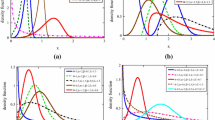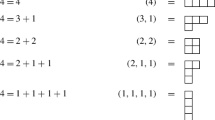Summary
Some statistical paradoxes arising from the use of non-conglomerable finitely additive distributions are discussed.
Similar content being viewed by others
References
De Finneti, B. (1972).Probability, Induction and Statistics, New York: Wiley.
— (1974).Theory of Probability, Vol. 1 and 2. New York: Wiley.
Dubins, L.E. (1975). Finitely additive conditional probabilities, conglomerability, and desintegrations.Ann Probability 3, 89–99.
Heath, D. andSudderth, W.D. (1976). On finitely additive priors, coherence, and extended admissibility.Ann Statist. 6, 333–345.
Hill, B.M. (1975). On coherence, inadmissibility, and inference about many parameters in the theory of least squares. InStudies in Bayesian Econometrics, and Statistics in Honor of Leonard J. Savage, (S.E. Fienberg and A. Zellner, eds.), Amsterdam: North-Holland, 555–584.
Lane, D. andSudderth, W. D. (1978). Diffuse models for sampling and predictive inference.Ann. Statist. 6, 1318–1336.
Jeffreys, H. (1967).Theory of Probability, Oxford: University Press.
Kolmogorov, A.N. (1950).Foundations of the Theory of Probability. New York: Chelsea.
Stone, M. (1976). Strong inconsistency from uniform priors.J. Amer. Statist. Assoc. 71, 114–116.
References in the Discussion
Bernardo, J.M. (1979). Reference posterior distributions for Bayesian inference (with discussion).J. Roy. Statist. Soc. B 41, 113–147.
Blyth, C.R. (1951). On minimax statistical decision procedures and their admissibility.Ann. Math. Statist. 22, 22–42.
Brenner, D. andFraser, D.A.S. (1979). Conditional probability and the resolution of statistical models.Statistische Hefte. (to appear).
Crook, J.F. andGood, I.J. (1979). Part II of Good (1976).Ann Statist. 20, 148–159.
De Finneti, B. (1971). Probabilitá de una teoria e probabilitá dei fatti.Studi di Probabilitá Statistica e Ricerca Operativa, 86–101. Universitá di Roma: Istituto di Calcolo delle Probabilitá.
— (1972).Probability, Induction, and Statistics. New York: Wiley.
DeRobertis, L. andHartigan, J.A. (1979). Ranges of prior measures.Tech. Rep. Yale University
Dickey, J.M. (1973). Scientific reporting and personal probabilities: Student’s hypothesis.J. Roy. Statist. Soc. B 35, 285–305.
Dickey, J.M. andFreeman, P.R. (1975). Population-distributed personal probabilities.J. Amer. Statist. Assoc. 70, 362–364.
Fine, T.L. (1971). Rational decision making with comparative probability.Proc. IEEE Conf. on Decision and Control. 355–356.
Fishburn, P.C. (1964).Decision and Value Theory. New York: Wiley.
— (1965). Analysis of decisions with incomplete knowledge of probabilities.Operations Research 13, 217–237.
Fraser, D.A.S. (1976).Probability and Statistics, Theory and Applications. Toronto: University of Toronto. Textbook Store.
Good, I.J. (1950).Probability and the Weighing of Evidence. New York: Hafners.
— (1952). Rational decisions.J. Roy. Statist. Soc. B. 14, 107–114.
Good, I.J. (1962). Subjective probability as the measure of a non-measurable set.Logic, Methodology, and Philosophy of Science: Proc. of the 1960 International Congress (Stanford), 319–329.
— (1965).The Estimation of Probabilities. Cambridge, Mass.: M.I.T. Press.
— (1967). A Bayesian significance test for multinomial distributions (with discussion).J. Roy. Statist. Soc. B. 29, 399–431.
— (1976a). On the application of symmetric Dirichlet distributions and their mixtures to contingency tables.Ann. Statist. 4, 1159–1189.
— (1976b). The Bayesian influence, or how to sweep subjectivism under the carpet.Foundations of Probability Theory, Statistical Inference and Statistical Theories of Science (Hooker, C.A. & Harper, W., eds.) Vol. 2, 125–174, Dordrecht: D. Reidel.
— (1977). Dynamic probability, computer chess, and the measurement of knowledge. InMachine Intelligence 8 (Elcock, E.W. and Michie, D., eds.) 139–150, New York: Wiley.
Good, I.J. andCrook, J.F. (1974). The Bayes/non Bayes compromise and the multinomial distribution.J. Amer. Statist. Assoc. 69, 711–720.
Hartley, R. (1978). On cone-efficiency, cone-convexity and cone-compactness.SIAM J. Appl. Math. 37, 211–222.
Heath, D.C. andSudderth, W.D. (1972). On a theorem of De Finetti, oddsmaking, and game theory.Ann. Math. Statist. 43, 2072–2077.
— (1978). On finitely additive priors.Ann. Statist. 6 333–345.
Hill, B.M. (1969). Foundations for the theory of least squares.J. Roy. Statist. Soc. B 31, 89–97.
Keynes, J.M. (1921).A Treatise on Probability. London: MacMillan.
Kolmogoroff, A. (1933).Grundbegriffe der Wahrscheinlichkeitsrechnung. Berlin: Springer. English translation asFoundations of the Theory of Probability. New York: Chelsea, (1950).
Koopman, B.O. (1940a). The basis of probability.Bull. Amer. Math. Soc. 46, 763–764.
— (1940b). The axioms and algebra of intuitive probability.Ann. Math. 41, 269–292.
Krantz, D.H. &et. al. (1971).Foundations of Measurement, Vol. 1. New York: Academic Press.
Skibinski, M. andCote, L. (1963). On the inadmissibility of some standard estimates in the presence of prior information.Ann. Math. Statist. 34, 539–548.
Smith, C.A.B. (1961). Consistency in statistical inference and decision.J. Roy. Statist. Soc. B 23, 1–25.
Stein, C. (1956). Inadmissibility of the usual estimator for the mean of a multivariate normal distribution.Proc. Third Berkeley Symp. 1, 197–206.
Villegas, C., (1964). On qualitative probability σ-algebras.Ann. Math. Statist. 35, 1787–1796.
—, (1967). On qualitative probability.Amer. Math. Month. 74, 661–669.
— (1977a). Inner statistical inference.J. Amer. Statist. Assoc. 72, 453–458.
—, (1977b). On the representation of ignorance.J. Amer. Statist. Assoc. 72, 651–654.
Author information
Authors and Affiliations
Rights and permissions
About this article
Cite this article
Hill, B.M. On some statistical paradoxes and non-conglomerability. Trabajos de Estadistica Y de Investigacion Operativa 31, 39–66 (1980). https://doi.org/10.1007/BF02888346
Issue Date:
DOI: https://doi.org/10.1007/BF02888346




